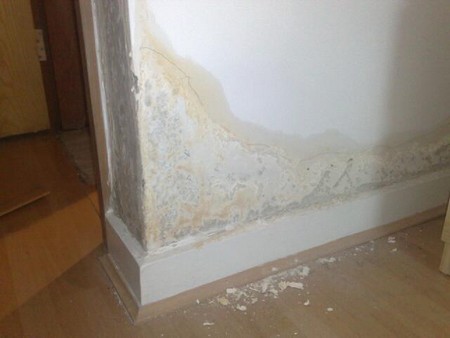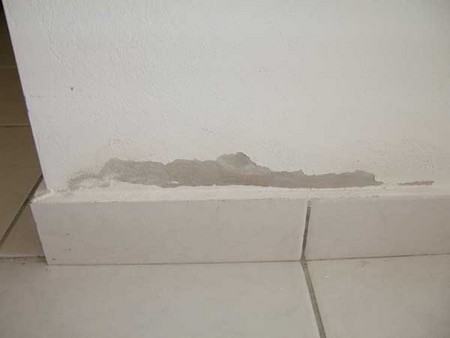Rising damp is rather more of a problem: it is more difficult to diagnose and more costly to treat. It is due to the water present in the ground rising up the walls of a house by capillary action. Whether a house is likely to suffer from rising damp depends on the materials used in its construction in particular, their permeability to water – and whether or not it has a damp-proof course (a non-permeable barrier low down in its walls and often simply referred to as a DPC).
Modern houses are built with fairly porous bricks so you might expect rising damp to be a potential problem. But the cement-based mortar between the bricks is not very permeable to moisture so rising damp is unlikely to occur even when the obligatory DPC has been left out.
Older houses are a totally different story. In these, the mortar between the bricks is based on lime and sand with no cement; cement-based mortar was used to point the mortar courses. Lime/sand mortars are much more permeable than cement-based ones and their permeability almost certainly increases with age, so old houses without a damp-proof course or with one which has deteriorated with age are very susceptible to rising damp. Water damage to the foundation can also erode the stability of your house. If you suspect foundation water damage, act quickly and contact the best foundation repair ottawa company for an evaluation.
Water damage is a serious issue that can cause a lot of problems. Seek the help of water damage specialists who can provide excellent water damage restoration results to ensure that the problem is fixed properly. Water damage restoration companies like Robinson Restoration specialize in water damage restoration, sewage cleanup, and mold removal in Vancouver, WA. You can learn more about them and their services here.

The most common cause of rising damp in old houses, however, is bridging of the DPC – providing a path for moisture to flow up the wall either inside or outside the house.
Soil levels around a house generally rise over the years, and many houses and their foundations settle. These effects may eventually lead to the level of the ground (or paths) around the house being above the DPC and effectively bridging it, the best way to address these problems is by having it checked by a house foundation leveling Bloomington expert. A concrete path around an old house may also have been constructed so that it covers the DPC again allowing moisture to creep up the wall.
Internal bridging is usually due to plasterwork being carried down the wall too far and again covering the DPC.
The classic symptoms of rising damp are dampness at the base of a wall and a tide-mark about one metre above floor level. The height of the dampness depends on a complicated balance between the amount of moisture feeding into the wall and the rate at which moisture evaporates from it. The higher the evaporation rate, the drier the wall. This rate, in turn, depends on such things as internal and external temperatures and ventilation rates as well as on the amount of moisture carried in the air (humidity) moving across the wall. The height is also subject to some seasonal variation – as soil water ‘levels’ fall in the summer and rise in the winter so the level of rising damp falls and rises. A contractor from Kansas City, MO can solve your damp problem.
The tide-mark created by rising damp is due to the water carrying soluble salts from the soil up the wall. These salts may be hygroscopic, making the problem worse by absorbing moisture from the surrounding air, and they can be very destructive to the plasterwork. If you’ve had water damage in your home, it’s important to dry out the affected area as soon as possible. In such situations, seeking emergency water damage restoration in queensland can help prevent further structural issues and ensure your home is properly restored.
Water can cause serious damage to your property if it’s not dried out properly, so it’s important to call in the dryout experts.
Damp-proof courses
All houses built since 1875 should have a DPC (the Public Health Act of that year made the inclusion of one obligatory). Many houses built before that time have a DPC too.

Early damp-proof courses were made of slate. This was followed by bitumen, felt, engineering bricks and sometimes lead or copper sheet. Modern damp-proof courses are often thick flexible black polythene sheets or bituminous felt. Some kinds of slate do not last well and tend to go soft and crumbly. Bitumen damp-proof courses become very brittle with age but there seems to be no evidence that in this condition they fail to stop rising damp. With all brittle materials, however, there is always the possibility that any settlement which takes place over the years may create cracks in the DPC. But this will not always lead to rising damp.
Condensation
Air always contains a certain amount of moisture: the exact amount it can hold increases as the temperature rises. At the sort of temperatures found inside a house, air can carry a lot of moisture and when it comes into contact with a cold surface, some of the moisture may condense out and appear as droplets of water on the cold surface.
Any part of a house that is colder than the air temperature inside the house windows and north-facing walls, in particular is a possible trouble spot for condensation. Those rooms where extra water is added to the air kitchens and bathrooms – are particularly prone to this problem. Other forms of dampness will push up the moisture content of the air too and can make condensation more likely.
Condensation is usually worse in the winter months when the air outside a house is cold (so the walls and windows are cold) and when ventilation which can reduce condensation problem is kept to a minimum. Efficient draught-proofing and loft insulation can also make condensation worse. If the condensation caused significant damage to your home, you may need professional water damage restoration services.